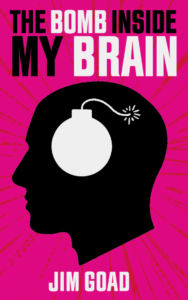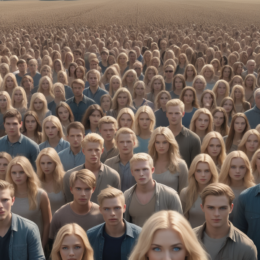The Worst Week Yet: February 11-17, 2024
Everyone (Except White Supremacists) Agrees: It’s a White Supremacist World!
As I stumble pell-mell into the morass of news stories, opinion columns, and academic essays that help me to form a mental hologram of what the hell is going on in this world every week, it seems as if everyone agrees that we live in a world that is thoroughly marinated in white supremacy. Ironically, everyone accepts this premise except the white supremacists. If you hang around those guys, you’ll quickly learn that their biggest lament is that it’s not a white supremacist world.
This week’s perambulations led me to repeatedly stub my toe on the idea that this world is absolutely sick with white supremacy — a notion that white supremacists would eagerly agree with, if only they thought it were true.
Up in Seattle, in tandem with something called “Black Lives Matter at School Week,” students at Lincoln High School received a handout purporting to define “9 characteristics of white supremacy.” According to a father of a student who received the handout, notions such as “objectivity,” “individualism,” and “perfectionism” were all dog whistles for white supremacy. The handout also allegedly stated that if students attempted to deny that they were racist, it would only prove that they are white supremacists. “How is a 15-year-old kid supposed to object in class when ‘denial and defensiveness’ is itself a characteristic of white supremacy?”, asked the unnamed father. “This is truly educational malpractice.”
In an essay for the Butler Collegian at Indian’s tiny Butler University, a disgruntled brown student named Sadia Khatri commands whites to “Stop weaponizing your white tears and guilt.” The essay, which doesn’t seem to contain even the semblance of a morsel of original thought and instead resembles the mental regurgitations of a non-white female in America’s heartland who eagerly swallowed everything they were telling her in college about white malfeasance, appears to allege that although white people are entirely justified in shedding remorseful tears about all the suffering they’ve caused to non-whites all over the world, Ms. Sadia Khatri thinks they’re being manipulative pains in the ass by crying and really need to shut the fuck up and allow her to browbeat them without so much as a whimper of protest:
White people weaponizing their privilege and guilt is nothing new. . . . Whiteness has always been weaponized against populations of color. When the white people who manipulate their privilege are called out, they often become highly defensive. . . .
When engaging in dialogue about their privilege and the deeply disturbing and harsh reality of racism and slavery in America, there are white people who feel so deeply uncomfortable that guilt and tears are all they can offer. . . .
White supremacy and anti-Blackness [sic] are so deeply embedded into our society that white privilege, guilt and tears are weaponized to seem like normal racial dynamics, where people of color are constantly gaslit about their experiences. . . .
White tears put racially marginalized individuals in a deeply uncomfortable situation. It now becomes our responsibility to console you for the guilt that you are experiencing because of what your ancestors may have done. It is ludicrous to hold the racially marginalized responsible for making sure that white people do not feel threatened by our experiences and histories.
The tears of white people — white women in particular — can have detrimental impacts. White women are often inherently perceived as virtuous “damsels in distress” who need to be sheltered. Their womanhood is honored as something innocent, precious and in need of protection. . . .
When white tears are shed, bodies of color pay the price.
However, as racially marginalized people, it is not our responsibility to console you for your white guilt. We will not apologize for the discomfort you feel. We will not feel sorry for your white tears.
Stop shedding your white tears and weaponizing your white fears against us.
I have a better idea: Go back to India and eat a bucket of samosas that squirm so hard with dysentery, they could crawl across the floor of their own accord.
A perusal of the Butler Collegian’s “About Us” page reveals that the humble publication only has a circulation of 700 copies and totals a mere eight pages per issue, and yet its 19-member editorial staff can only manage to crank out 24 issues per year. Only two of the 19 staff members appear to be men — both of whom are white — and apart from a black woman named Jada and an Asian girl named Mae Mae, all of the female staffers are likewise white. And yet this is the sort of nonsense they publish.
Whenever a black person refers to themselves as a “doctor,” I assume that if they’re not flat-out lying about it — a bold assumption, to be sure — that they’re either a Doctor of Divinity or a podiatrist. Perhaps a certain fat, black female social-media influencer who calls herself “Dr. Jebra Faushay” says she’s a “doctor” to divert attention from the fact that “Jebra” might be the dumbest black name I’ve heard all year. But if you click the link on her name there, you’ll see the modern state of the entitled and insufferable Dunning-Kruger modern black female urban rhino in all its snorting fury as she relates the savage tale of having to endure racist affronts from a little old white lady who deigned to tell her that she smells nice:
Well listen, we need to have a conversation. I know y’all give compliments a little bit different because of y’all culture or y’all lack thereof. But we gotta talk about this physical boundary y’all are constantly violating. I was not touched this time. But let me just give you the backstory.
Earlier this week I was in Walgreens. There was a little old white lady standing in front of the nail selection. I was in front of the eyelashes. I’m in Florida. I feel like that’s important to the story. Anywho, she was like, hmm, is that, is that you? And I was like, I beg your pardon? She was like, that smell? Is that you? Well, I wanted to say, well, whoever smelled it dealt it, bitch.
But I felt like that was a little standard for an 80-year-old woman on a Tuesday morning. So I was like, well, what does it smell like before I claim it? So she was like, oh, it’s very fragrant-y. I extended my arm. She sniffed. She said I smelled lovely. Fine. Good compliment. Whatever . . .
Sometimes they just want to sniff you and then I said I do not have one so it could not be that I turn around And a white lady is standing so close to me had she pursed her non-existent lips. She would have kissed me. So she’s like sorry if I startled you — you smell wonderful.
Startled? I’m startled, you bitch.
I almost passed out on this motherfucking floor. I almost passed out on this motherfucking floor. I’m gonna git my reparations one way or another.

You can buy Jim Goad’s Whiteness: The Original Sin here.
Girrrrrl, that seems like a rather extreme reaction to having someone compliment the way you smell. I’m sure that on any given day in America, there are at least one million little old white ladies who nobly bite their tongues and refrain from telling fat black women — fat black women such as you, Dr. Jebra Faushay — that you smell like a rancid mix of feet, feces, armpits, halibut, and desperation.
Robin DiAngelo is an intensely frail and brittle white woman who is so filled-to-the-gills with unearned shame and free-floating angst that at any moment she seems poised to have her entire face break into hundreds of ceramic shards that fall to the ground in guilty little pink pieces. She achieved white-guilt superstar status — and alleged speaking gigs that netted her white ass about $700K yearly — in 2020 when her 2018 book White Fragility rode George Floyd’s corpse to the top of the bestseller lists.
Perhaps she was slumming, or perchance she’s no longer in high demand, but the rapidly graying-and-wrinkling DiAngelo recently appeared on a podcast hosted by a gay-seeming bald black man named Jalon Johnson to assert that Michelangelo’s painting The Creation of Adam — which DiAngelo mistakenly referred to as God Creating Man — was quite likely the most white supremacist thing she’d ever fucking seen:
You may be surprised that the single image I use to capture the concept of white supremacy is Michelangelo’s Sistine Chapel God Creating Man [sic]. You know where, where God is in a cloud and there’s all these angels and he’s reaching out and he’s touching. I don’t know who that is David [sic] or something and God is white and David’s [sic] white and the angels are white, like that, that is the perfect convergence of white supremacy, patriarchy, right? . . . I was raised Catholic, so I saw many images like that as a child. So I’m sitting in raised Catholic, so I saw many images like that as a child. So I’m sitting in church and I’m looking up and I see these images. I don’t think to myself, oh, God is white. But that’s, in a lot of ways, it’s power, right? I don’t need to. God just reflects me. That doesn’t reflect me gender-wise, but it’s a non-issue. I always belong racially to what is seen, what is depicted as the human ideal.
The gay-seeming black bald host sort of smiled and nodded the whole time that DiAngelo was talking. I doubt he understood or appreciated a word she was trying to say, nor do I get the gut sense that DiAngelo is truly in touch with the dark and malevolent forces of buried trauma and self-hatred that impel her to appear in public to declare that she continues to allow a 500-year-old painting to fuck with her emotionally.
Rounding out this week’s Rolodex of headlines about the ever-elusive white supremacy that they tell us is everywhere but that none of us can ever seem to find is an academic paper written by a tomboyish woman named Sydney Sheedy, published in the European Journal of Cultural Studies, and bearing the unwieldy title “Queer occultism, sentimental biopower, and becoming ‘bottoms’ as a means to divest from white supremacy among practitioners of magic in Montréal.”
In case you’re fortunate enough not to immediately know what a “bottom” is, it’s someone who embraces the role of being the receptive partner during anal sex:
How does magic/psychic healing/occult represent an attempt to build capacity for receptivity among participants, and how is this capacity linked to the healing of white supremacy and colonization? . . .
While sensitivity is considered something that can be learned, queerness, rather than whiteness, emerges as a predisposition toward this learning, while white supremacy is figured as that which must be overcome. . . .
In this article, I begin to develop a theory of ‘bottoming’ as a prerogative that is particularly salient to white informants, in order to unlearn and thus repair what they see as the fallout of white supremacist legacies, including settler colonialism, capitalism, and environmental degradation. . . .
I want to theorize the capacity to ‘bottom’, or become radically receptive, as the prerogative of white people as an antidote to histories of infringement and violent confrontation that informants see themselves as descendants of, and wish to overturn. . . .
‘Bottoming’ is offered as a strategy for surrendering power, which has the potential to overturn centuries of imposition and trespass, which white people in particular recognize as work that they need to do.
In other words, if white people truly wish to make amends to their non-white victims to atone for several centuries of raping, pillaging, burning, murdering, and drawing unflattering cartoons of them, they should literally bend over, grab their ankles, and permit themselves to be anally penetrated by non-whites.
Political Gender Gap Widens among the Young, Quotient of Young People on Multiple Psych Meds Grows, and Everyone in America Stopped Hanging Out

You can buy Jim Goad’s The Bomb Inside My Brain here.
A new Gallup report titled “U.S. Women Have Become More Liberal; Men Mostly Stable” concludes that women aged 18 to 29 are now 15% more likely (40% to 25%) than men of the same age to identify as liberal. In 2000, the gap was only three percent.
Men, however, identify with labels such as “conservative,” “liberal,” and “moderate” at roughly the same quotients that they have for the past quarter-century. Women are the ones who’ve taken a hard left turn, and in a world where “71% of Democratic college students said they wouldn’t go on a date with someone who voted for the opposing presidential candidate,” they probably won’t mate and breed, either, and it all fits quite comfortably in what I suspect is a manufactured crisis of political polarization between the sexes.
A new study from the State of Maryland examining trends among Medicaid patients 17 or younger from 2015 through 2020 found a nearly ten-point increase in “polypharmacy” — defined as “taking three or more different classes of psychiatric medications, including antidepressants, mood-stabilizing anticonvulsants, sedatives and drugs for A.D.H.D. and anxiety drugs” — in 2020 compared to 2015:
The latest study looked at data from 126,972 people over the study period. It found that in 2015, 4.2 percent of Medicaid enrollees under the age of 17 in Maryland had overlapping prescriptions of three or more different classes of psychiatric medications. That figure rose to 4.6 percent in 2020.
Beware any overmedicated population, but especially an overmedicated youth population coming of age at a time that seems uniquely hopeless.
In an essay for The Atlantic published on Valentine’s Day, Derek Thompson grapples with the question of “Why Americans Stopped Hanging Out,” especially the paradox of epidemic isolation and loneliness as we drown amid “unprecedented terabytes of interpersonal communication”:
From 2003 to 2022, American men reduced their average hours of face-to-face socializing by about 30 percent. For unmarried Americans, the decline was even bigger — more than 35 percent. For teenagers, it was more than 45 percent. Boys and girls ages 15 to 19 reduced their weekly social hangouts by more than three hours a week. In short, there is no statistical record of any other period in U.S. history when people have spent more time on their own.
Aloneness is not loneliness. Not only that, one might point out, the texture of aloneness has changed. Solitude is less solitary than ever. With all the calling, texting, emailing, work chatting, DMing, and posting, we are producing unprecedented terabytes of interpersonal communication. . . .
The share of young people who say they have a close friend has plummeted. Americans have been so depressed about the state of the nation for so many consecutive years that by 2023, NBC pollsters said, “We have never before seen this level of sustained pessimism in the 30-year-plus history of the poll.” . . .
The sum result of these trends is that we are both pushed and pulled toward a level of aloneness for which we are dysevolved and emotionally unprepared. Sartre said hell is other people. Perhaps. But the alternative is worse.
True hell is when you only see other people through a glass screen.
To review: This week we learned that although we live in a world which aggressively batters the very idea of white people, we are also forced to admit, under threat of social excommunication if we refuse, that it’s actually a white-supremacist society that unfairly advantages us. We also live in a world where young men and women have been so poisoned by the hyper-politicization of everything that they barely talk to one another, much less do boy-girl things such as holding hands, kissing, heavy petting, and the occasional round of rutting. In Maryland at least, one in every 20 kids is doped-up on a cocktail of three or more psychiatric drugs. And no one socializes anymore because they’re all on social media.
Let’s hope for a better week next week.




